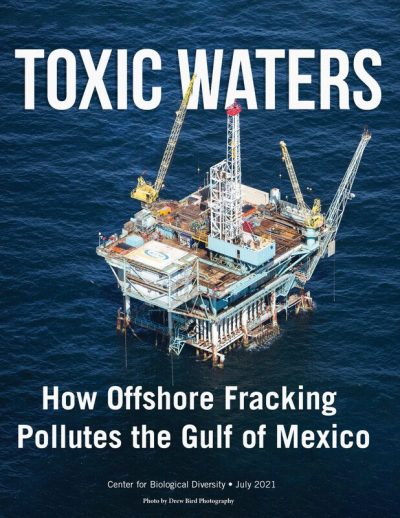Offshore Fracking Report Finds Toxic Pollution in Gulf of Mexico
Over 3,000 Fracks, 66.3 Million Gallons of Fracking Waste Dumped Since 2010

All Global Research articles can be read in 51 languages by activating the “Translate Website” drop down menu on the top banner of our home page (Desktop version).
Visit and follow us on Instagram at @crg_globalresearch.
***
A report released today by the Center for Biological Diversity details how pervasive and damaging offshore fracking and other extreme oil and gas extraction methods have become in the Gulf of Mexico since 2010.
Based on an analysis of federal records obtained through the Freedom of Information Act and published scientific studies, the report documents more than 3,000 instances of offshore fracking, 700 cases of acidizing offshore wells, and at least 66.3 million gallons of fracking waste dumped into the Gulf over a decade.
Chemicals used in offshore fracking and acidizing pose significant health risks to both humans and wildlife, including cancer, reproductive harm, neurotoxicity and even death. The increasing use of fracking could threaten the tourism and fishing industries, which account for about 2.85 million jobs on the Gulf Coast — or about 10 times the number of jobs in the region’s federal offshore fossil fuel industry.
“Offshore fracking threatens Gulf communities and wildlife far more than our government has acknowledged. To protect life and our climate, we should ban these extreme extraction techniques,” said Miyoko Sakashita, oceans program director at the Center. “A decade into the offshore fracking boom, officials still haven’t properly studied its public health impacts. The failure to curb this major source of pollution is astounding and unacceptable.”
Offshore fracking has become a near daily occurrence over the past decade. Fracking, or hydraulic fracturing, blasts water and chemicals into the seafloor to fracture rock and release oil and gas. Acidizing injects hydrofluoric or hydrochloric acid to etch pathways in rock walls and release the fossil fuels.
The U.S. Environmental Protection Agency allows companies to discharge unlimited amounts of fracking wastewater into the Gulf. An industry report to the EPA found that each frack releases about 21,480 gallons of fracking waste, including biocides, polymers and solvents, into the Gulf of Mexico.
These chemicals kill aquatic species in laboratory tests that simulate concentrations of the substances found near offshore platforms. Many chemicals used in fracking are known to harm reproduction and development, yet about 76% of the chemicals used in fracks haven’t even been studied for their impacts on human and wildlife health.
Despite the known health risks of many fracking chemicals and the lack of knowledge about many others, the federal government approves extreme well-stimulation methods at a rapid rate.
Today’s report, titled Toxic Waters: How Offshore Fracking Pollutes the Gulf of Mexico, is available here.
*
Note to readers: Please click the share buttons above or below. Follow us on Instagram, @crg_globalresearch. Forward this article to your email lists. Crosspost on your blog site, internet forums. etc.
Featured image: Cover of Toxic Waters report (Photo by Drew Bird Photography)

